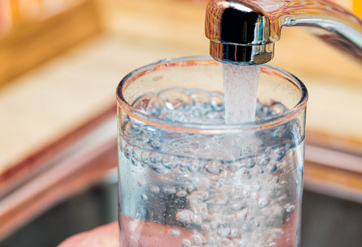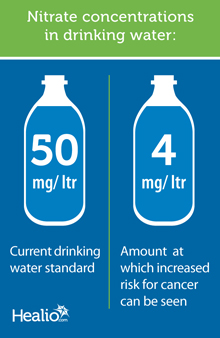Colon Cancer Risk Linked to Nitrate in Drinking Water, Even at ‘Safe’ Levels
A large epidemiological study published in the International Journal of Cancer reported that nitrate in drinking water, even at low levels, correlated with an increased risk for colorectal cancer.
These findings confirmed long-held suspicions that long-term exposure to nitrate — a common groundwater contaminant that primarily originates from agricultural fertilizers — may be linked to cancer risk, according to investigators. The risk, they said, results from nitrate converting into carcinogens called N-nitroso compounds after ingestion.
“Each year, approximately 5,000 Danes contract colorectal cancer, which can have many causes,” Jörg Schullehner, PhD, from the Department of Public Health at Aarhus University in Denmark, said in a press release. “Our study shows that nitrate in drinking water may be one of them. In the study, people who were exposed to the highest concentration of nitrate in drinking water (above 9.3 mg per liter of water) had a 15% greater risk of getting colorectal cancer compared to those who had least exposure (less than 1.3 mg per liter of water).”
Schullehner and colleagues assessed nitrate exposure among 2.7 million adults based on 200,000 drinking water analyses from 1978 to 2011, and included 1.7 million individuals with the highest exposure levels in their main analysis, with follow-up beginning at age 35 years. Using population-based health registry data, they identified 5,944 incident CRC cases during 23 million person-years at risk.

Those with the highest exposure levels showed a significantly increased risk for CRC vs. those with the lowest exposure levels (HR = 1.16; 95% CI, 1.08-1.25). Separate analyses of colon cancer (HR = 1.15; 95% CI, 1.05-1.26) and rectal cancer (HR = 1.17; 95% CI, 1.04-1.32) showed similar associations.
These risks remained significant even at low levels of nitrate deemed acceptable by current drinking water standards.
“The current drinking water standard is 50 mg nitrate per liter of water, but the increased risk of cancer could already be seen at concentrations greater than approximately 4 mg nitrate per liter of water,” Schullehner said in the press release.

“The conclusion in our study is in line with the findings of several international studies, which indicates that the drinking water standard ought to be lower in order to protect against chronic health effects and not only acute effects such as Blue Baby Syndrome,” Torben Sigsgaard, PhD, from the Department of Public Health at Aarhus University, said in the press release. “With identical results from different studies, this points towards a need for reconsidering the drinking water standard.”
Fortunately, nitrate levels in Denmark’s public waterworks have declined over the past decades, according to research from the Geological Survey of Denmark and Greenland, which collaborated on this study.
“Nitrate concentrations are low in the majority of public waterworks,” Schullehner said in the press release. “Today, the problem is mainly concentrated in the small private wells, as well as places with high nitrate leaching and where the local soil- and geological conditions mean that nitrate can more easily be leached to the groundwater. It therefore makes sense to focus our efforts here.” – by Adam Leitenberger
Disclosures: This study was supported by the Innovation Fund Denmark as part of the research alliance DNMARK: Danish Nitrogen Mitigation Assessment: Research and Know-how for a sustainable, low-nitrogen food production (www.dnmark.org). Additional support was received through a scholarship given by the Centre for Integrated Register-based Research at Aarhus University (CIRRAU).
